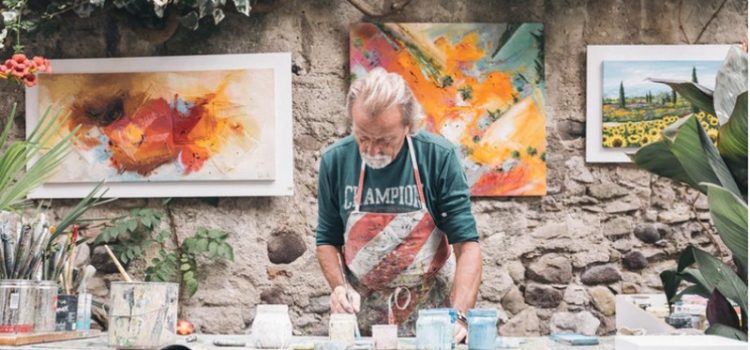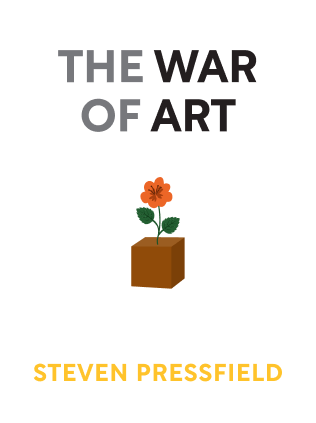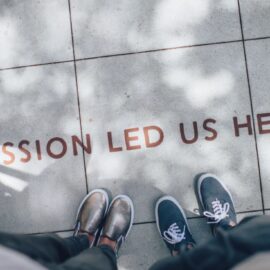

This article is an excerpt from the Shortform book guide to "The War of Art" by Steven Pressfield. Shortform has the world's best summaries and analyses of books you should be reading.
Like this article? Sign up for a free trial here .
Do you want to know how to be an artist? How can you let go of self-doubt to achieve your creative ambitions?
In The War of Art, Steven Pressfield writes about the common obstacles artists face when trying to achieve their creative dreams. Self-doubt and fear often get in the way, but it’s important to overcome these hurdles and focus on your true calling. If you want to know how to be an artist, you need to know what is holding you back.
Keep reading to find out how to be an artist.
How to Be an Artist
The following steps will teach you how to be an artist, overcome self-doubt, and achieve your creative ambitions.
Step 1: Find Your True Calling
You were not born a blank slate. You were born with a particular soul and brand of characteristics. You were told the world is your oyster, but that’s a lie. You have a specific purpose in life—your true calling—and your job is to discover what it is and follow it.
If you were born to be a leader, you must become a leader. If you were born to nurture children, you must seek out positions that require nurturing, such as a mother or teacher. If you were born to be an artist, you must create art.
Only you know what your true calling is—what you were born to do. And only you can decide what to do with the genius you’ve been given. You can do the work or not do the work, it’s up to you. But if you choose not to write a novel, paint a mural, cure cancer, or develop the Internet, realize you are hurting yourself and everyone else that may benefit from your gift.
Using your gift to create your art is typically an isolated enterprise, but it is not a selfish one. You’re following through on the life bestowed to you. You are using your unique spirit to create the work you were meant to create. This gift wasn’t given to you by mistake. If you feel it, you’re meant to use it. A muse waits in your divine space to provide you with the many blessings they have to offer. All you have to do is call upon them and be grateful.
Step 2: Let Go of Self-Doubt and Fear
If you want to know how to be an artist, it’s important to understand what is holding you back. Any artist following their calling is going to experience doubt about their talents. The little voice in your head saying you’re not good enough is resistance. But you can use that voice to empower yourself.
Doubt is a sign that something is important to you. When you express doubt, you’re signifying your passion about reaching your potential. If you ever wonder whether you’re really an artist, know that the answer is yes. Imposters tend to be overconfident because their souls are not on the line. True artists have everything to lose. If you experience doubt, it’s a good sign that you’re on the right track to your heart’s desire.
Likewise, fear is a huge indication that you’re headed toward personal growth. Fear can be tricky because, as mentioned, it activates resistance and gives it strength. But you can counteract the relationship between fear and resistance by using fear as a guide. As a general rule—the more you fear the work, the more you should pursue it.
Many actors only take roles that scare them. They do this because these roles challenge their abilities and push them out of their comfort zones. They see an opportunity to grow and get closer to their full potential. The same is true for you. You feel so much resistance when you’re scared to pursue something because the work means something to you. If it didn’t, you’d feel no resistance. Use your fear to propel you forward because the deeper parts of yourself and talent lie on the other side.
You can’t predict what will happen with your art once you create it. But if you don’t create it, you guarantee the answer is nothing. Your only certainty is that doing the work fulfills your destiny. The rest is out of your hands. If the idea of doing the work for the sake of the work is too hard to swallow, think of other ways to measure success.
Step 3: Do the Work and Access Your Muse
If self-doubt and fear are the forces working against you, then the muse is the force working in your favor. Access to your muse is another aspect of what makes working like a true artist so important. Something mysterious happens when you come to your art every day. The forces of your artistic power accumulate around you. The muse sees your work and commitment and rewards you with inspiration.
Some refer to professionalism as the “artist’s code” because they know the artist works in service of the art without arrogance. Others call it the “warrior’s way” because, like warriors, you must slay dragons and fight the enemy daily to win the battle for your work. The muse is what enhances your power during the battle and helps you find your way to the gates of your destiny.
To form a strong relationship with your muse, you must first understand what a muse is, where it comes from, and how to harness its power.
When you have an idea and commit to creating it despite fear, you clear the path for the authentic you to come through. Starting is like the first contraction after the long gestation period of your idea. The muse works like a midwife to help bring the person you were meant to be into this world.
The small act of sitting down to write that first sentence or paint that first stroke or draw that first blueprint is an invitation to your muse. You invite the muse to sit at your table and give them the space to do their work. They’re happy and you’re happy. When you’re both happy, you will receive the guidance you need to bring your work to fruition.
When you sit down to work, recognize the muse and show gratitude for the gifts it will bring to you. Be humble in what you ask for. The muse’s job is not to give you fame and fortune. The muse gives you inspiration, which helps you continue to work. That is all you can hope for and all you should ask for—the ability to maintain your work. If your goal is anything else, you are not yet a professional, and the muse will know it.
Now you must decide what you believe and how you will use those beliefs to become your authentic self. You won’t be able to document or prove that forces from higher planes conspire in your favor. You won’t be able to name the moment the muse speaks to you. You won’t be able to differentiate between what is your work, the muse’s work, or the work of your higher mind. All you can do is trust the process and receive your rewards. Those rewards will be happiness, fulfillment, and purpose.
If you can let go of your Ego, you can succeed. If you can stand up to resistance, you can succeed. If you can be humble and accept your role as servant to the muse, you can succeed.
You must become a warrior in the fight for control over your life. You must be willing to share the spotlight with inspiration and view yourself as an instrument it works through. You must remember that you are an artist, not the art. You must commit to doing whatever the work entails. If you can do these things, the rest will take care of itself.
Step 4: Be a Professional, Not an Amateur
Artists who fold under the pressure of fear have one thing in common: they’re amateurs. You might say, “Well, I don’t get paid to make art, so I’m an amateur by definition.” In the world of sports, that distinction is true. In the world of artists, the distinction between amateur and professional falls under different categories.
When you’re an amateur, you dabble in your art. You venture into the foray of art when the mood suits you or to have fun. Art is your hobby or a part-time commitment. You may love to create art, but the love doesn’t come from the depths of your soul. It’s a fair-weather love that fades at the first sign of fear. Resistance loves an amateur because you are easily distracted from the work.
When you’re a professional, you create art because you have to. You turn to art because your soul demands it and because you feel incomplete without it. Your art is a full-time commitment, even if you aren’t getting paid. You sit down to face your art daily because it is part of who you are. The transition from amateur to professional is akin to having your first child. Your priorities change, and how you approach your life changes. Resistance hates the professional because you are less likely to be thwarted from the work at hand.
The great thing about being a professional is the access you have to your muse. Each time you sit down and face your art, you open the portal to your artistic space, where the muse resides. Within this universe, this mysterious force conspires to bring you inspiration because you are committed to your art.
There is a difference between the you who works within your spirit genius and the you who you share with the world. Fear wants you to believe the two are the same person. This belief distracts you with concerns about losing the public you when you choose the artistic you (i.e., your true authentic self). But who you are with the rest of the world is separate from who you are in the artistic world. The two worlds will never collide, so you don’t need to worry about it. You can live with both easily. The following concepts show you the difference between the two worlds so you won’t fall for resistance’s tricks.
Isolation
Most artistic pursuits require solitude. This understanding is important because resistance tries to convince you that isolation is a bad thing. You fear losing your community or place within it. You fear the sensation of loneliness.
The key is to remember that when you’re doing the work of your calling, you’re never alone. When you engulf yourself within your true work, your muse comes forth to keep you company. (We’ll talk more about the muse in Part 3.) The act of committing to your work is an act of courage, and courage opens up deeper parts of your soul. Those parts are creative, raw, and magical. They pull you out of reality and immerse you in a timeless space where your heart is full and the outside world ceases to exist. The artistic you lives in this space, and you’re the only one who can access it.
Timelessness
You only experience the sensation of timelessness when you are working within your passion. Your mind and soul are fully engaged when the outside world disappears. Hours go by without you realizing it, and the work doesn’t feel like effort. If you find yourself within that timeless space, you know you are doing work that fulfills your true calling. This knowledge can help you keep working when resistance tries to intervene.
Healing
One of the ways resistance tries to manipulate the barrier between the artist and the person is through healing. You may have personal demons or past traumas you struggle with emotionally and psychologically. Resistance makes you believe you need to heal those parts of you before you can start your important work. But this is not true. As stated, your artistic space cannot be touched by the outside world because it lives deep within your spirit landscape. This space is safe from external influences, even those that affect you internally. The part of you affected is the public sphere, which has nothing to do with your true artistic pursuits.
What’s interesting is that healing the psychological mind does not impact the artistic mind, but healing the artistic mind does impact the psychological mind. When you tap into your spirit and pursue your calling, the positive effects seep into your total being. The emotions you tackle in the work are emotions you want to understand more. When you connect with the work, you are working toward an understanding of those emotions, which leads to personal growth.
When you make the first step toward your artistic calling, you cast a vote in favor of your life. By proxy, your whole being becomes empowered. On the other hand, when you focus your psychic energy on psychological healing, you’re taking it away from the work, and resistance has won.
Of note, not all desires or attempts to heal your psychological self are bad. They are only negative when they stop you from getting to work.
The previous chapters make resistance sound like a scary monster lurking around every corner. You may be feeling overwhelmed and ill-equipped to manage it. But remember, everyone pursuing their calling experiences resistance. If it couldn’t be beaten, there’d be no art, no novels, no vaccines, and no Internet. When the journey to defeating resistance seems impossible, just remind yourself that people have been defeating it since the beginning of time. Here’s how to become one of them.
Reflection Exercise: Can You Win the Battle for Your Soul?
This article helps you to find out what is holding you back from your dreams and how to be an artist. It also provides information to help you succeed.
- How has reading this article changed how you approach creativity in your life? Reflect on what you’ve learned about how to be an artist.
- What are two ways you feel more prepared to achieve your goals now?
- Why is it important for you to achieve your calling in life?
- Name two ways you will move forward with the information in this article to change your life.

———End of Preview———
Like what you just read? Read the rest of the world's best book summary and analysis of Steven Pressfield's "The War of Art" at Shortform .
Here's what you'll find in our full The War of Art summary :
- Why creative people feel resistance when approaching their true work
- How to break down the wall that holds you back from reaching your potential
- How to tap into your creative power and honor the genius you were born with






